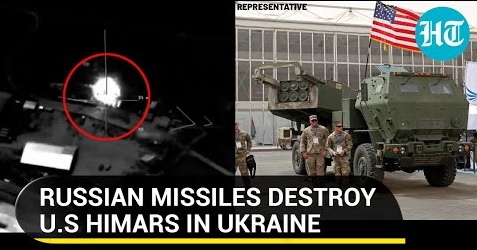
On January 1, the Military Informant Telegram channel published a video purportedly showing a HIMARS that had just fired a salvo coming under fire from cluster munition dispensing artillery rockets near Konstantinovka. The launcher was reportedly destroyed. While the evidence supporting HIMARS neutralization isn’t clinching, there can be little doubt that Russia was able to strike the HIMARS before it had time to completely withdraw from the launch area, which itself is a significant feat because of the challenges in engaging a HIMARS, writes ‘The Eurasian Times’.
The highly accurate SATNAV and INS guided rockets can engage high-value targets 40 km behind adversary lines even when launched from the safety of a point 50 km behind the frontline, outside the range of most Russian kamikaze drones and MLRS systems.
The time taken by a HIMARS to fire all its rockets is classified and can vary depending on the type of rockets being used, the firing sequence, and the operational procedures of the crew.
What we can say with certainty is that the time taken to launch all rockets and scoot is less than the sum of the flight time to the target of the GMLRS rockets, the time taken by a Weapon Locating Radar to process the trajectory of the rockets, and relay HIMARS coordinates to a counter-battery MLRS, and the flight time to the HIMARS of the counter-battery fire rocket!
One possible explanation would be that the counter-battery rockets were fired before the HIMARS rockets arrived at the target area, significantly reducing the response time and cutting off the HIMARS escape.
In which case, the question would be – How did the Russians pinpoint the launch point without using a Weapon Locating Radar, which calculates the approximate launch point by plotting the trajectory of the rocket?
It’s highly likely that the plume of the GMLRS rocket was picked up by a Russian reconnaissance system, and the precise launch coordinates were immediately transmitted to the counter-battery MLRS.
If Russia has now acquired the means to detect the plume of a GMLRS rocket, the impact on the future course of the Special Military Operation (SMO) will not be trivial.
Russian Reconnaissance System Likely In Play?
Terminal homing on rockets would be essential for assured destruction. The capability will eventually be deployed. However, the increased threat faced by US HIMARS systems deployed behind Ukrainian lines is now already substantive enough to curb their use.
The claimed destruction of two US HIMARS launchers, if true, may well turn out to be yet another harbinger of a Ukrainian capitulation in 2024.
read more in our Telegram-channel https://t.me/The_International_Affairs

 10:46 06.01.2024 •
10:46 06.01.2024 •






















